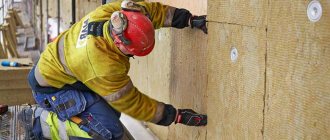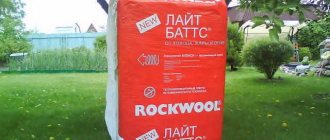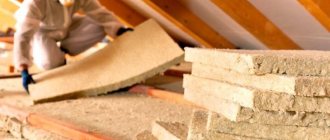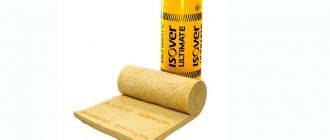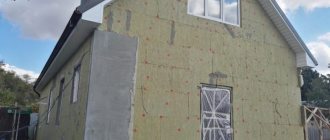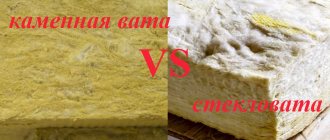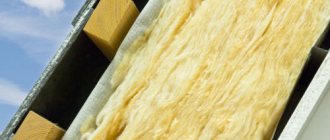Mineral wools firmly occupy a leading place in the world as heat and sound insulating materials, both in terms of production volume and in the number of houses insulated with them. In Europe and Asia, the most famous and recognizable is Rockwool insulation, which has won such close attention with high quality standards and constant updating of the product line, innovative products with unique properties or that stand out for their strict purpose, where other similar insulation cannot compete with them.
Rockwool technology, technical characteristics
Rockwool is an ecological material that is obtained by melting rocks and stretching them into thin threads impregnated with a binder. The result is stone wool with a fibrous structure. The production technology allows us to produce strong, moisture-resistant and easy-to-handle slabs with improved sound-absorbing properties and mechanical resistance to compression.
Materials production technology
Thin and elastic threads create chaotic weaves and provide high resistance of the material to deformation and shrinkage. The basalt component for the production of mineral wool ensures non-flammability and guarantees increased strength of products under the Rockwool brand. There are two factories of the company in Russia - in Zheleznodorozhny and in Vyborg, they are equipped with the most modern equipment for production.
The Rockwool group of companies is a world leader in the production of materials for insulating premises - ceilings, floors, partitions, house facades. For each design there are special materials produced by Rockwool. In Russia, Rockwool materials based on mineral wool are very popular, as is Isover mineral wool, among large construction companies and individual developers.
Advantages of a thermal insulator
Rockwool insulation is impregnated with fire retardants, therefore it is completely fireproof.
Rockwool basalt wool successfully competes with the best examples of organic insulation. Compared to them, it has the following advantages:
- environmental cleanliness of the raw materials themselves and the entire process of processing and manufacturing the final product;
- good thermal conductivity;
- minimizing binders harmful to humans;
- excellent sound-absorbing properties;
- waterproofing, defined as hydrophobicity;
- impossibility of reproduction of parasitic microflora, rodents and harmful insects.
One of the key advantages of the material is fire safety, the level of which it surpasses well-known synthetic analogues.
Technical characteristics of Rockwool insulation
The Rockwool company produces a wide range of products in the form of rolls and plates. The following types of thermal insulators are in greatest demand today: “Light Butts”, “Facade Butts” and “Acoustic Butts”. Rockwool mineral wool has different technical characteristics, and depending on them, the slabs are used inside or outside buildings. The main characteristics include:
Thermal conductivity . Rockwool mineral wool has the best indicator among its competitors - 0.036-0.038 W/m K (Watt per meter per Kelvin). The effectiveness of thermal insulation directly depends on this indicator. And the density of the material ensures maximum energy efficiency of a residential building.
Flammability (fire resistance). Stone wool belongs to the class of non-combustible materials (NG) and can withstand temperatures up to 1000 degrees Celsius. In the event of a fire, the insulation does not emit smoke and prevents the spread of fire in the room.
Resistance to deformation is ensured by the chaotic arrangement of the finest fibers, ensuring their dense weaving, rigidity and stability of the shape of the mats. Facade Butts mats are used as thermal insulation for facades - they are dense and rigid, resistant to deformation. In addition, Flexi mats have a springy edge on the long side of the slab.
Vapor permeability . Hydrophobicity and vapor permeability determine the ability of a material to absorb and repel water, as well as allow air to pass through. If you do not provide a vapor barrier when installing the insulation, the thermal insulation qualities will begin to decrease as moisture is absorbed. Waterproof Light Butts mats are used in lightweight structures as a non-load-bearing layer.
Soundproofing . The ability of the material to protect the room from noise is excellent. Between the fibers of the material there is a layer of air that traps all sounds. The degree of sound insulation is influenced by the density and porosity of the Rockwool insulation structure. Sound-absorbing mats Acoustic Butts provide sound-absorbing capacity (within 43-62 dB).
Tips and tricks
For any work with stone wool insulation, it is necessary to use personal protective equipment - a respirator, gloves, special suits. Despite the high level of environmental friendliness and safety, this will prevent the development of allergies, since there is a small risk of dust during installation.
The durability and strength of the structure directly depends on correct and competent installation. Thus, an adhesive solution or special disc anchors are suitable for attaching rigid insulation. For lightweight structures, installation against frame sheathing is quite suitable.
The vapor barrier layer is always placed closer to the cold side of the building. However, when insulating internal walls, it is placed closer to the warm side.
If for some reason the work is not carried out immediately after purchasing the material, then the insulation should be stored only in indoor areas, avoiding interaction with high humidity. It is allowed to store packages on top of each other, but only on a flat, dry surface.
Waterproofing and any other membranes are mounted with the logo facing out. But vapor barrier for roofs, walls and ceilings - with the logo inside the room.
Description of thermal insulation materials Rockwool
The company offers all brands of products to Russian consumers. Rockwool products in Moscow are designed for a wide range of insulation work. Everyone will find the Rockwool products that are needed to solve specific problems and a specific application.
Rockwool Venti Butts is a rigid waterproof material produced in the form of slabs. Rockwool Venti Butts is used for use as a thermal insulation layer in curtain wall systems with an air gap for single-layer and double-layer Rockwool thermal insulation.
Technical characteristics of Rockwool venti butts insulation
Rockwool light butts are waterproof boards for lightweight structures (partitions, attics, balconies, etc.). Rockwool light butts are produced with the new Flexi technology - the plate has a springy edge, which makes installation of the plates faster and more convenient.
Technical characteristics of Rockwool light butts insulation
Rockwool roof butts are slabs of increased rigidity made of basalt-based mineral wool insulation. Rockwool roof butts are used as a thermal insulation layer for roofing without cement screed.
Technical characteristics of Rockwool roof butts insulation
Rockwool facade butts are dense and rigid slabs for thermal insulation of external facade walls, made of basalt. Rockwool facade butts slabs are resistant to deformation and are a reliable basis for the plaster layer when finishing using the wet facade method.
Technical characteristics of Rockwool insulation façade butts
Rockwool floor butts – slabs for thermal insulation of floors. Rockwool floor butts are rigid and waterproof mats designed for the installation of acoustic floors, as well as for thermal insulation of floors in a private house over the ground.
Technical characteristics of Rockwool floor butts insulation
Rockwool acoustic butts are used as a layer in the construction of frame partitions and cladding, interfloor ceilings, as well as for additional sound insulation of ceilings. The material meets all the requirements of sound-absorbing materials not only from Rockwool.
Technical characteristics of Rockwool acoustic batts insulation
How to calculate thermal insulation parameters?
Calculating thermal insulation parameters is always a difficult process for a non-professional. When choosing the thickness of the insulation, it is important to take into account many criteria - wall material, climatic characteristics of the region, type of finishing material, features of the purpose and design of the area used.
There are special formulas for calculations; you can’t do without SNiPs. Leading manufacturers of thermal insulation materials have significantly simplified the process of determining thermal insulation parameters by creating special formulas.
One of the best formulas belongs to the Rockwool company. You can use it by indicating in the appropriate columns of the online calculator the type of work, the material of the insulated surface and its thickness, as well as the desired type of insulation. The program will produce the finished result in a matter of seconds.
To determine the required volumes of the heat insulator, you should calculate the area to be insulated (multiply the length and width). Once you know the area, it is easier to choose the optimal size of insulation, as well as calculate the number of mats or slabs. To insulate flat horizontal surfaces, it is more convenient to use roll modifications.
Insulation is usually purchased with a small, up to 5%, reserve in case of damage to the material and taking into account its cutting and filling the seams between the elements of the heat-insulating layer (the joints of 2 adjacent slabs).
Content
- Main products of the Rockwool brand
- Specifications
- Release forms
- Thermal conductivity
Rockwool stone wool (the original name of the ROCKWOOL brand, but in Russia, according to our data, consumers more often request the name in Cyrillic writing) is a product of natural origin.
This is a natural stone in its composition. It is because of this that the material has become popular for use in various types of buildings. Stone wool is used for thermal insulation of any structures - these include multi-storey buildings and detached premises, including those with very strict environmental and sanitary requirements, such as children's institutions or hospitals and health resorts. The technology for making rockwool stone wool is sometimes compared to the process of erupting volcanic rocks. Once the stone reaches the factory, it is melted in furnaces at very high temperatures (up to 1500 degrees C). A substance resembling lava is formed. In a special centrifuge, when processed with powerful air currents, the mass turns into individual stone fibers. A certain amount of binding components is added to the fibers. This is necessary to give the desired shape to the fiber. Water-repellent components are also added to the composition. The resulting fibers are formed into slabs, which are then left to harden.
If you don’t have time to read the article, just watch the visual video and you’ll get an idea of the properties of Rockwool stone wool:

